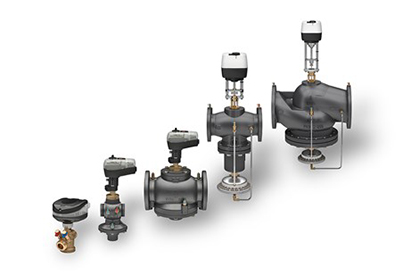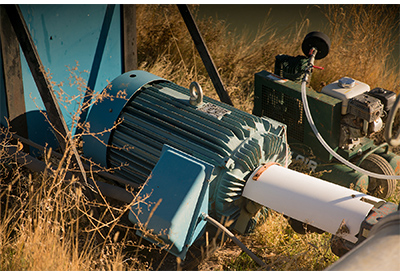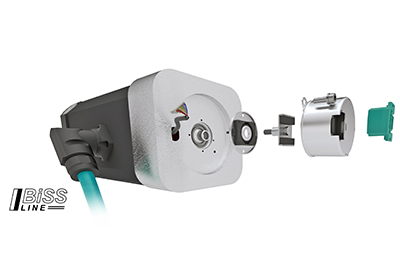Danfoss: NovoCon M, L and XL – Big News for Fans of IoT Solutions in Smart Building Concepts

March 16, 2021
Roughly 5 years ago Danfoss introduced NovoCon S, the first of its kind digital actuator specially designed for AB-QM pressure independent control valves (PICVs). At the time this was a revolutionary actuator for controlling flow’s through terminal units in hydronic HVAC applications. With it’s bus-communication for BACnet MS/TP or Modbus RTU protocols, NovoCon S was a front runner in establishing new and innovative IoT solutions for smart buildings.
Meanwhile the concept of NovoCon is widely spread and used by many fans of smart HVAC solutions. The increased attention and usage also leads to new demands. As NovoCon S fits to AB-QM valves in sizes DN 10 up to DN 32 the nominal flow is limited to 4,000 l/h. Other hydronic HVAC applications such as Air Handling Units (AHUs), Chillers and other high flow applications, still needs to be controlled with conventional actuators.
Introducing NovoCon M, L and XL
In early August of 2020, Danfoss were proud to introduce their new NovoCon M, L and XL digital actuators. The new actuators, in conjunction with the AB-QM valves, achieve high-precision dynamic hydronic balancing and control for high flow applications.
The NovoCon M, L and XL are specifically designed to accurately control high flow rates. In specific:
- – The NovoCon M is used for AB-QM NovoCon valves in DN 40-100 suited for flows from 3-59 m3/h, e.g. for air handling units
- – The NovoCon L is used for AB-QM valves in DN 125-150 suited for flows from 36-190 m3/h, e.g. for chillers
- – And NovoCon XL is used for AB-QM valves in DN 200-250 suited for flows from 80-370 m3/h, e.g. for district cooling
Unlike the NovoCon S, the new NovoCon M, L and XL don’t use plug & play connectors and cables. Instead the actuators can be daisy-chain wired using standard cables which makes it easier to cover longer distances. The actuators are equipped with 3 resistance inputs to connect e.g. temperature sensors. When such sensors are installed on the supply and return connections, the NovoCon actuators can be used for advanced control functionalities like Delta T limitation or Return temperature control. With these functionalities the energy efficiency of the AHU or Chiller can be optimized.
NovoCon 4-in-1 solution
Danfoss NovoCon actuators effectively combine four functions into one smart solution:
- – Accurate flow control due to linear characteristic at different differential pressures and built-in step motor
- – Bus actuator due to the BACnet MS/TP and Modbus RTU communication protocols
- – I/O device due to the Resistance inputs (3x), Analog input (1x) and Analog output (1x)
- – Energy manager due to the advanced algorithms for monitoring and energy management
Danfoss NovoCon actuators can be digitally controlled via BACnet or Modbus communication protocols, enabling easy integration and providing actual system performance data into higher-level building management systems. The I/O interfaces can for example be used to connect sensors to measure supply and return temperatures and calculate the energy consumption. The I/O ports are also available for controlling individual devices such as fans or connecting BMS room temperature controllers. This means that all relevant system parameters and control options are always available for centralized HVAC energy management and energy efficiency optimization as part of comprehensive smart building concepts.
Hydronic HVAC data made available
Danfoss NovoCon actuators can be digitally controlled via BACnet or Modbus communication protocols, enabling easy integration and providing actual system performance data into higher-level building management systems. The I/O interfaces can for example be used to connect sensors to measure supply and return temperatures and calculate the energy consumption. The I/O ports are also available for controlling individual devices such as fans or connecting BMS room temperature controllers. This means that all relevant system parameters and control options are always available for centralized HVAC energy management and energy efficiency optimization as part of comprehensive smart building concepts.
Engineering HVAC 4.0 for smart buildings
The combination of AB-QM and NovoCon actuators is a good example of the increasing digitalization in HVAC. The combination does not only establish high precision, dynamic, hydronic balancing and control. The digital actuators provide BMS with real-time HVAC data to enable Active Energy Management (AEM). Digital valve control via fieldbus also offers advantages in remote commissioning, flow setting, flushing, predictive maintenance and energy allocation. Automatically generated alarm messages support fast and accurate troubleshooting. HVAC 4.0 continuously optimizes the energy efficiency and comfort of buildings by using smart and connected products and services.
The now established full-range series of NovoCon® digital actuators enable HVAC 4.0 solutions in smart building concepts. In this way they create a fundamental basis for efficient energy use in large non-residential and commercial buildings, such as hotels, office buildings, data centers, shopping centers and hospitals.





